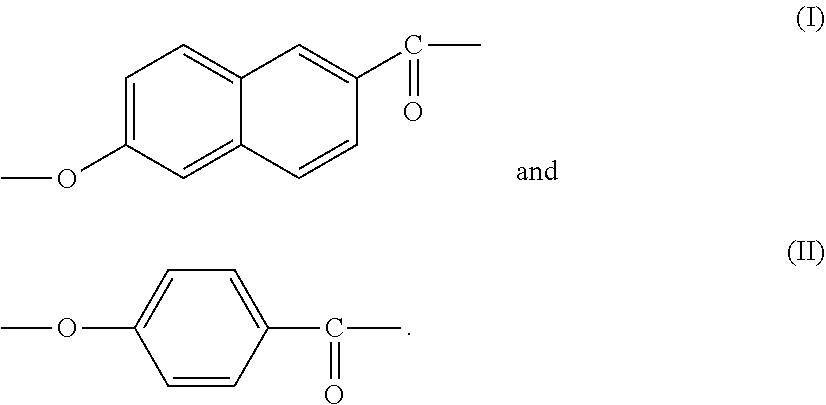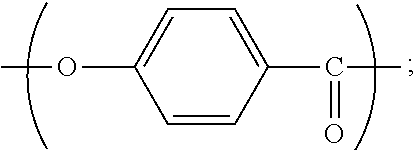Liquid crystal polymer film and laminate comprising the same
- Summary
- Abstract
- Description
- Claims
- Application Information
AI Technical Summary
Benefits of technology
Problems solved by technology
Method used
Image
Examples
preparation example 1
LCP Resin
[0041]A mixture of 6-hydroxy-2-naphthalenecarboxylic acid (700 g, 3.72 mole), 4-hydroxybenzoic acid (954 g, 6.91 mole), terephthalic acid (285 g, 1.71 mole), acetyl anhydride (1085 g) and sodium phosphite (1.3 g) was charged into a 3-liter autoclave and stirred for acetylation at 160° C. for about 2 hours under nitrogen atmosphere at normal pressure. Subsequently, the mixture was heated to 320° C. at a heating rate of 30° C. per hour. Under this temperature condition, the pressure was reduced slowly from 760 torr to 3 torr or below, and the temperature rose from 320° C. to 340° C. Afterwards, the stirring power and the pressure were increased, and steps of discharging polymers, drawing strands, and cutting strands into pellets were conducted to obtain an LCP resin having a melting point of about 265° C. and a viscosity of about 20 Pa·s @300° C. Wherein, based on the total molar number of the structural unit in the LCP resin which could be represented by Formula (1), the mol...
preparation example 2
LCP Resin
[0042]A mixture of 6-hydroxy-2-naphthalenecarboxylic acid (540 g, 2.87 mole), 4-hydroxybenzoic acid (1071 g, 7.75 mole), acetyl anhydride (1086 g), sodium phosphite (1.3 g), and 1-methylimidazole (0.3 g) was charged into a 3-liter autoclave and stirred for acetylation at 160° C. for about 2 hours under nitrogen atmosphere at normal pressure. Subsequently, the mixture was heated to 320° C. at a heating rate of 30° C. per hour. Under this temperature condition, the pressure was reduced slowly from 760 torr to 3 torr or below, and the temperature rose from 320° C. to 340° C. Afterwards, the stirring power and the pressure were increased, and steps of discharging polymers, drawing strands, and cutting strands into pellets were conducted to obtain an LCP resin having a melting point of about 278° C. and a viscosity of about 45 Pa·s @300° C. Wherein, based on the total molar number of the structural unit in the LCP resin which could be represented by Formula (1), the structural u...
preparation example 3
LCP Resin
[0043]A mixture of 6-hydroxy-2-naphthalenecarboxylic acid (440 g, 2.34 mole), 4-hydroxybenzoic acid (1145 g, 8.29 mole), acetyl anhydride (1085 g) and sodium phosphite (1.3 g) was charged into a 3-liter autoclave and stirred for acetylation at 160° C. for about 2 hours under nitrogen atmosphere at normal pressure. Subsequently, the mixture was heated to 320° C. at a heating rate of 30° C. per hour. Under this temperature condition, the pressure was reduced slowly from 760 torr to 3 torr or below, and the temperature rose from 320° C. to 340° C. Afterwards, the stirring power and the pressure were increased, and steps of discharging polymers, drawing strands, and cutting strands into pellets were conducted to obtain an LCP resin having a melting point of about 305° C. and a viscosity of about 40 Pa·s @320° C. Wherein, based on the total molar number of the structural unit in the LCP resin which could be represented by Formula (1), the structural unit in the LCP resin represe...
PUM
| Property | Measurement | Unit |
|---|---|---|
| Length | aaaaa | aaaaa |
| Length | aaaaa | aaaaa |
| Thickness | aaaaa | aaaaa |
Abstract
Description
Claims
Application Information
 Login to View More
Login to View More - R&D
- Intellectual Property
- Life Sciences
- Materials
- Tech Scout
- Unparalleled Data Quality
- Higher Quality Content
- 60% Fewer Hallucinations
Browse by: Latest US Patents, China's latest patents, Technical Efficacy Thesaurus, Application Domain, Technology Topic, Popular Technical Reports.
© 2025 PatSnap. All rights reserved.Legal|Privacy policy|Modern Slavery Act Transparency Statement|Sitemap|About US| Contact US: help@patsnap.com



